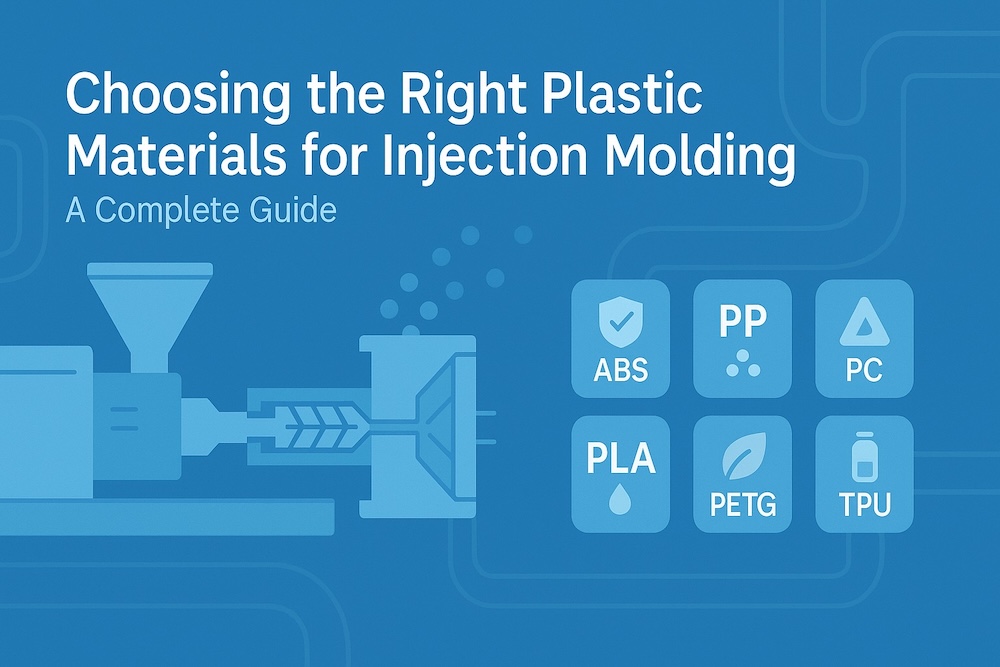Choosing the Right Plastic Materials for Injection Molding: A Complete Guide
Choosing the Right Plastic Materials for Injection Molding: A Complete Guide

Choosing the Right Plastic Materials for Injection Molding: A Complete Guide
Keywords: plastic injection molding materials • thermoplastic molding • biodegradable plastics • engineering plastics
Material choice shapes cost, performance, cosmetics, compliance, and time-to-market. The wrong resin can inflate cycle time, warp critical dimensions, or fail in the field. This guide gives you a practical framework—then dives deep into ABS, PP, PC, PLA, PETG, TPU so you can select with confidence and document a defensible RFQ.
Explore our end-to-end workflow from DFM to tooling to production:
Custom Mold & Design Maker • Mold Service • Injection Mold • Molding • Customer Examples • Contact
A Fast Framework for Resin Selection
-
Environment & durability: temperature, UV/chemical exposure, drop/impact, creep.
-
Regulatory: food contact, electrical (UL 94, CTI), medical biocompatibility, recyclability/ESG.
-
Cosmetics: gloss, transparency, color ΔE, texture (SPI), paintability or RHCM needs.
-
Manufacturing efficiency: flow length vs. wall, cycle time (cooling), tool wear, thermoplastic molding window.
-
Commercials: cost/kg, supplier availability, color masterbatch logistics, MOQ, lead time.
Get a 48-Hour DFM & Cost Pack with gating/cooling maps and cycle models:
→ Custom Mold & Design Maker • Validate on press: Molding
Quick Comparison Matrix (ABS, PP, PC, PLA, PETG, TPU)
| Resin | Type | Strength/Impact | Heat/HDT | Chemical/UV | Transparency | Cost | Typical Uses |
|---|---|---|---|---|---|---|---|
| ABS | Engineering plastics | High/High | Med | Med/Med | Opaque | $$ | Housings, appliance trims, snaps |
| PP | Commodity thermoplastic | Med/Good hinge | Med-Low | Excellent/Capped UV | Translucent | $ | Caps, living hinges, packaging |
| PC | Engineering plastics | Very high | High | Med/Needs UV | Clear | $$$ | Lenses, guards, load-bearing parts |
| PLA | Biodegradable plastics | Med/Brittle | Low | Low/Low | Clear | $$ | Eco packaging, prototypes |
| PETG | Copolyester | Med/Good | Med-Low | Good/Good | Clear | $$ | Transparent covers, POP, trays |
| TPU | Elastomer | Tough/Flexible | Med | Good/Good | Translucent | $$$ | Overmold grips, gaskets, wearables |
For resin-specific DFM and mold quotes:
→ Injection Mold • Mold Service
Material Profiles: Properties, Applications, Pros & Cons
ABS (Acrylonitrile-Butadiene-Styrene) — Versatile, Paint-Friendly
-
Why choose: balanced strength/impact, stable dimensions, great paint/plate, crisp textures.
-
Applications: consumer electronics housings, appliance trims, automotive interior bezels, gear doors, clips.
-
Pros: easy processing, good cosmetic surfaces, wide color range, bondable/paintable.
-
Cons: moderate chemical resistance; UV needs stabilization or overmold/paint.
-
DFM tips: walls 2.0–3.0 mm typical; ribs 40–60% wall; draft ≥1.0–1.5° textured.
-
Cell setup: hot tip or valve gate for A-surfaces, balanced cooling for gloss control.
Learn about tooling surface classes and textures: Injection Mold • See projects: Customer Examples
PP (Polypropylene) — Lightweight, Hinge-Ready, Cost-Efficient
-
Why choose: low density, great chemical resistance, living hinge capability.
-
Applications: packaging injection, caps/closures, hinges, appliance internals, medical disposables.
-
Pros: low cost, fatigue resistance (hinges), excellent chemical resistance.
-
Cons: lower heat resistance than PC/ABS; can warp on large panels; UV needs stabilization outdoors.
-
DFM tips: uniform walls 1.2–2.5 mm; hinge zones 0.25–0.50 mm with flow across hinge; fan/film gate for skins.
-
Process: higher mold temps improve gloss and weld strength; vision SPC for gate vestige.
Prototype-to-production for PP hinges: Molding • Rapid DFM: Custom Mold & Design Maker
PC (Polycarbonate) — Impact-Clear, Heat-Capable
-
Why choose: very high impact plus transparency; strong at elevated temps.
-
Applications: lenses, light pipes, guards, medical/device covers, helmets/shields.
-
Pros: clarity with toughness, high HDT, good dimensional stability.
-
Cons: sensitive to stress cracking with certain chemicals; scratch-prone without coating; needs UV stabilization outdoors.
-
DFM tips: wall 2.0–3.5 mm for optics (depends on path/clarity); gate away from viewing zones; consider RHCM for paint-free gloss.
-
Process: dry thoroughly; higher mold temp for clarity; protect surfaces from eject scuff.
Optical tooling and RHCM discussion: Injection Mold • Validation flows: Molding
PLA (Polylactic Acid) — Bio-Based, Compostable in Industrial Streams
-
Why choose: biodegradable plastics option with good stiffness and clarity for eco packaging and pilot products.
-
Applications: concept packaging, trays, cosmetic components with short service life, educational products.
-
Pros: bio-based origin, attractive clarity, low warp at moderate geometries, easy coloring.
-
Cons: lower heat deflection (softening near 55–60 °C), limited chemical resistance, slower crystallization; end-of-life depends on industrial composting.
-
DFM tips: avoid high-heat environments; maintain uniform sections 1.5–3.0 mm; prioritize venting.
-
Process: tight temperature control to prevent degradation; consider blends for toughness/heat.
Sustainability options and trade-offs: Customer Examples • Pilot builds: Molding
PETG (Glycol-Modified PET) — Clear, Tough, Easy to Form
-
Why choose: clear like PC but easier to process with fewer internal stresses; good chemical/impact for displays.
-
Applications: transparent guards, cosmetic packaging, POP displays, medical trays (non-autoclave).
-
Pros: clarity, good impact vs. standard PET, low warp, printable/bondable.
-
Cons: lower heat than PC; hot surfaces can scratch; solvent selection matters.
-
DFM tips: wall 1.5–3.0 mm; gate off A-surfaces; protect ejector contact; consider texture to hide scuffs.
-
Process: dry material; moderate mold temperature for surface quality; careful demold handling.
Surface/texture and color ΔE controls: Injection Mold • Case snapshots: Customer Examples
TPU (Thermoplastic Polyurethane) — Flexible, Abrasion-Resistant, Bond-Friendly
-
Why choose: elastomer with superb abrasion resistance and overmold bond to PC/ABS/PA—ideal for grips and seals.
-
Applications: device grips, wearable bands, gaskets, vibration isolators, wheels.
-
Pros: high tear/abrasion resistance, flexible at low temps, pleasant haptics.
-
Cons: cycle time longer than rigid plastics; moisture-sensitive; shore range must match function (A-to-D).
-
DFM tips: maintain even wall to avoid sink in soft parts; plan bond windows for 2K overmold; use seam-vision in cell.
-
Process: thorough drying, controlled cooling; use robot EOAT and soft tooling inserts to protect surfaces.
2K/overmold pilots and seam detection: Molding • Tooling choices: Mold Service
DFM Rules That Prevent Costly Re-Cuts
-
Uniform walls; ribs ≈ 40–60% of wall; core heavy bosses to reduce sink.
-
Draft: ≥1.0–1.5° textured; ≥0.5° polished faces.
-
Gate strategy: fan/film for large skins; valve/sequential for long flows and weld-line control; keep off A-surfaces.
-
Cooling: parallel circuits, ΔT ≤5 °C; consider conformal cooling at hot spots.
-
Overmold bonds: define substrate grade + TPE/TPU chemistry; specify peel/shear targets and seam vision rules.
Request a 48-hour DFM & Moldflow review:
→ Custom Mold & Design Maker • Scale plan: Mold Service
Processing & Troubleshooting Cheatsheet
| Symptom | Likely Cause | First Fixes |
|---|---|---|
| Short shots (PC/PETG) | Low melt/mold temp; small gate | Raise temps; fan gate; confirm venting |
| Sink at bosses (ABS/PP) | Starved pack; mass too thick | Increase pack; core bosses; rib tie-ins |
| Weld-line weakness (PC/ABS) | Low melt front temp | Raise mold temp; sequential valves; RHCM for cosmetics |
| Splay/silvering (PETG/PLA) | Moisture; hot spots | Dry resin; balance temps; check check-ring |
| Warpage (PP large panels) | Cooling imbalance; fiber orientation | Parallel circuits; conformal inserts; gate move/sequence |
| Poor TPU bond | Wrong substrate/TPE pair; dirty surface | Validate chemistry; clean surfaces; adjust mold temp/time |
Run a scientific molding DOE and lock the golden recipe:
→ Molding • Data-ready tooling: Injection Mold
Sustainability & Compliance Notes
-
Biodegradable plastics (PLA): confirm end-of-life route (industrial composting vs. recycling stream).
-
Food contact (PP/PETG grades): scope migration/sensory plans; keep colored lots traceable.
-
Electrical (PC/ABS, PBT blends): UL 94, CTI; maintain datasheet trail and lot genealogy.
-
ESG/KPI: track kWh/kg, scrap, and regrind policy in MES.
See how we document compliance in production: Molding • Explore example packs: Customer Examples
RFQ Template (Copy/Paste)
Subject: RFQ – Plastic Injection Molding Materials Selection & Tooling
Attachments: STEP/IGES + 2D with CTQs & cosmetic map
-
Target resin(s): ABS / PP / PC / PLA / PETG / TPU (or shortlist)
-
Annual volume & first PO qty; color SKUs; packaging needs
-
Environment: temperature, UV, chemical exposure, drop/impact targets
-
Cosmetic & surface class: SPI texture, ΔE/gloss targets, transparency
-
Special features: inserts, threads, living hinges, 2K/overmold (TPU)
-
Inspection pack: FAIR, CMM/scan, GR&R, capability at CTQs
-
Compliance: food contact / electrical / biocompatibility / sustainability goals
-
Timeline: T0/T1/buy-off/SOP; Incoterms
Get help refining this RFQ with a 48-Hour DFM & Cost Pack:
→ Custom Mold & Design Maker • Request quotes: Mold Service • Ask a process question: Contact
Why TaiwanMoldMaker.com
-
Material-savvy DFM across engineering plastics, clear optics, biodegradable plastics, and elastomers.
-
Tooling depth: valve-gated hot runners, conformal cooling, 2K/overmold, scientific molding instrumentation.
-
Data & quality: ISO 9001 network; IATF 16949 / ISO 13485 available; MES dashboards for OEE, CpK, scrap, kWh/kg.
Dive deeper: Injection Mold • Molding • Customer Examples
Call to Action
Ready to shortlist materials and de-risk your design? Send CAD and requirements to receive a 48-Hour DFM & Cost Pack—resin trade-offs, cycle estimates, gating/cooling concepts, and a pilot-to-scale plan.
→ Request an Instant Quote • Or start with DFM here: Custom Mold & Design Maker








